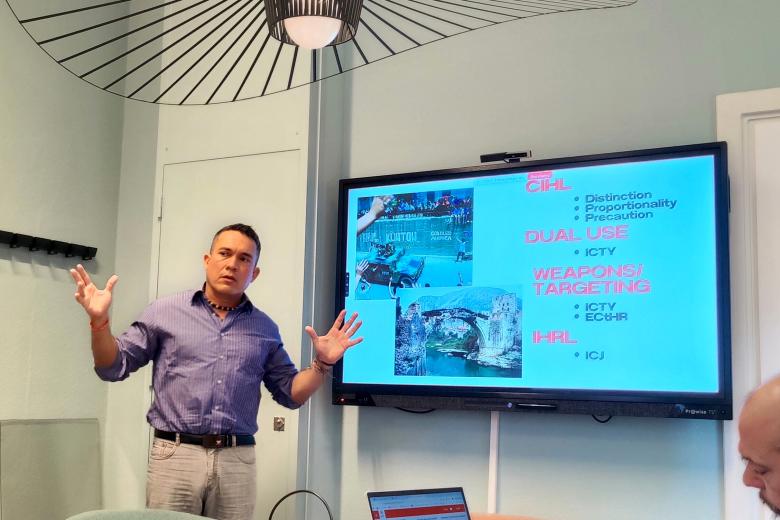Beyond whacky trips: the therapeutic potential of psychedelics
Magic mushrooms et al have gone from being vilified to being hyped as a panacea. Natasha Mason studies the neurological mechanisms and therapeutic potential of psychedelics. How a surge in glutamate and increased neuroplasticity might be a mental health game-changer.
The results are in: psychedelics make you feel funky. But wait, there’s more. “There’s a reliable, acute increase in empathy - people feel more for others, even if they can’t always pinpoint what the other person is feeling. People feel more connectedness to the world around them, and also feel emotions more intensely in general. They also report being able to think about their circumstances from new, different perspectives,” explains Natasha Mason, Assistant Professor in Psychopharmacology at the Faculty of Psychology and Neuroscience.
Mason researches psychedelics for their therapeutic use. “It is very promising – in our and others’ studies, it’s been shown that just one or a few administrations reduce symptoms of (treatment-resistant) depression, anxiety, PTSD or addiction for weeks, months, and potentially even years”.
How psychedelics work
Psychedelics, such as LSD, Psilocybin, DMT, Mescaline or MDMA, are a class of psychoactive substances. While what is being studied today are mainly synthetic drugs, they have a long history in native populations of the American continent. “Ayahuasca for example has been used by Amazonian tribes for a long time, but what role exactly it played in those societies isn’t that clear. We shouldn’t romanticise too much and distinguish historic research from narratives for tourists.”
Psychedelics do many things in the brain, but one therapeutically important action they have is to increase the concentration of glutamate, the main excitatory neurotransmitter, in certain brain regions. “This leads to an increase of neuroplasticity for several hours or days. In this window, the brain is more open to change, so psychotherapeutic interventions can be especially effective by helping them shift toward more adaptive patterns of thinking and behaving – at least, that is what myself and others are studying now”.
How psychedelics went from taboo to hype
Psychedelics are in the ascendancy as a research topic. Already in the 60s and 70s, they were a very hot topic – too hot, in fact. A moral panic around the countercultural movement in the US meant that research into their therapeutic use lay dormant for many decades. “Not so long ago, it really was taboo, with stories circulating about people going mad or staring at the sun until they go blind. Even 11 years ago, when I wanted to pursue this line of research, my advisors in the US told me to keep it quiet until it becomes more acceptable…” Instead, Mason dug up a very short list of institutions world-wide who conducted research into psychedelics. She chose to come to UM and join the group of Kim Kuypers and Jan Ramaekers. She hasn’t looked back since.
In the meantime, the pendulum of public opinion has swung the other way, with psychedelics being touted as a panacea for all sorts. “We need to be realistic. Some people in the 60s used it very irresponsibly and often in very high doses. We need to develop exact treatment protocols: how much, how often, under which conditions, in combination with which therapeutic interventions, and so on. You also have to keep in mind that people are under the influence and that they’ll need support. That alone marks a significant shift from the current psychiatric treatment model, where patients are typically prescribed medication to take daily at home. This means a lot has to change regarding our approach to treating psychiatric disorders.”

Natasha Mason is Assistant Professor of Psychopharmacology at Maastricht University’s Faculty of Psychology and Neuroscience (FPN)
How psychedelic research works
Maybe disappointingly, Mason’s lab is bare of batik scarves, sitars and tablas. Student volunteers with prior experience taking psychedelics are talked through the entire process and reminded that whatever they feel will wear off after some hours. After administering the drug, e.g. psilocybin, Mason observes changes both in behaviour and brain activity. “We put participants in an MRI scanner and have them perform cognitive tasks. We observe their functional connectivity, so how different regions of the brain communicate and work with each other.”
To test the popular claim that psychedelics increase creativity, Mason uses flexible thinking tasks, such as how many alternate uses participants can think up for a for a common object. She also researches empathy by showing pictures of emotional states and asking participants to identify those emotions and how much they feel for the person in the picture. “We then relate those observations to changes we measure in the brain. We also look at the long-term effects to see whether participants’ mood and behaviour change even after the drug’s effects have worn off.”
What psychedelics can do for us
Mason has shown that psychedelics reliably and acutely increase empathy, not only towards strangers, but also between partners in romantic relationships. “People feel more connected to each other, emotional stimuli have more impact. That is therapeutically relevant because in depression, we often see a decrease in empathy and a sense of disconnectedness. People feel very alone and suffer as a result.”
When it comes to creativity, the effect is less clear-cut. “Creativity is really hard to measure, of course. After counting the alternate use responses, we have to evaluate how new and useful the answers are.” Mason found no acute increase in creativity. “Actually, we see an impairment, which isn’t surprising since your executive functioning is affected under a psychedelic. However, in the days following, people tend to have more novel ideas.”
This delayed effect can be therapeutically relevant, especially for individuals with conditions like depression, who often become stuck in maladaptive thought patterns. If psychedelics can help them think more flexibly and gain novel perspectives on their circumstances, they may be better able to break free from these patterns.
Overall, she enjoys her experience working with participants. “They’re usually in a very good mood. There is a lot of laughing. They have fun in the lab and are happy to chat about their experience. That said, there can be moments of confusion too. Imagine you’re in the middle of a psychedelic experience, and someone asks you to list all the things you can do with a cup. You may wonder what you are doing and why. After they complete the study we do explain what the purpose was, and that’s when they see how all of these tasks that they did fit into the bigger scientific picture.”
Why psychedelics are important
Mason herself developed an interest in the topic while studying Pharmacy. “I was most interested in drugs for mental health issues and worked in a pharmacy to gain experience. I was confronted with patients talking about side-effects, from insomnia to weight-gain or loss of libido. I grew a bit disillusioned and read review papers into alternatives, such as psychedelics. While there was very little good, recent research, the thing that really spoke to me was that it promised cures rather than ways of suppressing symptoms.”
When it comes to pharmaceutical interventions for treating depression, scientific development has stalled in recent decades, Mason explains. The prevailing solutions have their issues too. “With SSRIs [the most established family of drugs against depression], people don’t experience psychoactive effects, but they also can have potentially life-threatening side effects, such as suicidal ideation. It can also take weeks for people to experience any therapeutic relief – that’s a long time when you aren’t feeling well.” In contrast, psychedelics are showing promise in reducing symptoms for people with treatment-resistant depression, i.e. individuals who haven’t responded to SSRIs or other standard treatments. For them, psychedelics may offer a much-needed alternative path forward.
The bright future of therapeutic psychedelics
Mason sees tremendous potential in psychedelics since they produce rapid and significant differences with very few administrations. “That’s why it’s quite frustrating that this field of research is sometimes still not taken as seriously as it should be. People with depression suffer a lot and the medications we have can come with serious side-effects.”
A step towards more recognition might be Mason’s nomination for the New Scientist Wetenschapstalent 2025, a prize awarded via a scientific jury and a public vote. “Obviously I feel very honoured! Mostly, though, I see it as validation of research that has the potential to help many people.” She remains realistic. “It’s still early days. We need more results to get regulatory approval. Many pharmaceutical companies are eager to develop psychedelics into medicines, and it’s generally assumed we’ll be there in 5 years or so.” Her disappointingly ungroovy prediction moving forward? Development of “a psychedelic-like medication that retains the biological benefits, , i.e. the neuroplasticity, but without the trippy part, since, for many people, that can be an undesirable ‘side-effect’.”
Natasha Mason has been nominated for the New Scientist Science Talent 2025. Vote her to victory!
Text: Florian Raith
Photo: Joey Roberts
Also read
-
Andrés Caceres Solari on No room for Human Rights in Gaza and Ukraine: How the Law Legitimizes Urban Devastation
Pick Our Brains Session with Andres Caceres Solari

-
AMIBM hosts the final Realise-Bio conference
The Aachen Maastricht Institute of Biobased Materials (AMIBM) hosted last week the third and final Realise-Bio annual conference, bringing together the Dutch and German bioeconomy ecosystems at the Brightlands Chemelot Campus.

-
Macrophages as key to treating liver fibrosis
Sabine Daemen is researching how certain macrophages can slow down fatty liver disease and fibrosis in order to develop new therapies.
